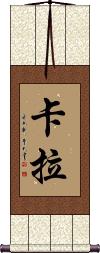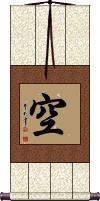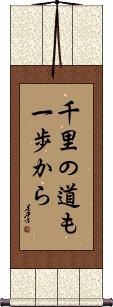Many custom options...
And formats...

Kara in Chinese / Japanese...
Buy a Kara calligraphy wall scroll here!
Personalize your custom “Kara” project by clicking the button next to your favorite “Kara” title below...
Kara
Kara
Law of the Fist Karate / Kempo Karate
The first two characters mean “fist law” which is Romanized from Japanese as “Kenpo” or “Kempo.”
The last two are a secondary way to express “karate.”
Notes:
The more common way to express “karate” is literally “empty hand” (meaning “without weapons in your hand”). This version would be translated literally as “Tang hand” (as in the Tang Dynasty) or “China hand” (sometimes “Tang” means “China” in Japanese). Even though the character for “Tang” is used instead of “empty,” it's still pronounced “kara-te” in Japanese.
拳法唐手 is not commonly used in China - so please consider it to be a Japanese-only title.
Many Japanese people will say the last two Kanji are the old and antiquated way of saying Karate. This fact does not stop this title from existing, as these four characters are often seen in Kenpo / Kempo Dojos around the western world.
Kajukenbo Slogan
拳法功夫 is the Japanese slogan associated with Kajukenbo.
There is no way to write Kajukenbo in Japanese (as the “ka” for karate cannot be separated from the “kara” character it is supposed to represent - among a few other language issues). This slogan which reads, “fist law, kung fu” is often written on banners and patches for Kajukenbo clubs or dojos.
Sky / Ether / Void / Emptiness / Unreality
(Used in Japanese version of five elements)
空 is a single character that means empty, void, hollow, vacant, vacuum, blank, nonexistent, vacuity, voidness, emptiness, non-existence, immateriality, unreality, the false or illusory nature of all existence, and being unreal.
In the Buddhist context, this relates to the doctrine that all phenomena and the ego have no reality but are composed of a certain number of skandhas or elements, which disintegrate. The void, the sky, space. The universal, the absolute, complete abstraction without relativity. The doctrine further explains that all things are compounds, or unstable organisms, possessing no self-essence, i.e. are dependent, or caused, come into existence only to perish. The underlying reality, the principle of eternal relativity, or non-infinity, i.e. śūnya, permeates all phenomena making possible their evolution.
From Sanskrit and/or Pali, this is the translation to Chinese and Japanese of the title śūnya or śūnyatā.
In Japanese, when pronounced as “ron” (sounds like “roan”) this can be a given name. It should be noted that this Kanji has about 5 different possible pronunciations in Japanese: kuu, kara, sora, ron, and uro. 空 is also an element in the Japanese version of the five elements.
A Journey of 1000 Miles Begins with a Single Step
senri no michi mo ippo kara
千里の道も一歩から is the Japanese version of an ancient Chinese proverb that means “a journey of a thousand miles begins with a single step.”
Some will also translate this as a 1000-mile road starts with one brick (a small amount).
In this case, the real measurement is an ancient Chinese “li” or 里, which is romanized as “ri” in Japanese. It's about half a kilometer, so three 里 would be a western mile. A journey of 333 miles begins with a single step, just doesn't sound as natural.
Note: Because this selection contains some special Japanese Hiragana characters, it should be written by a Japanese calligrapher.
Not the results for Kara that you were looking for?
Below are some entries from our dictionary that may match your Kara search...
| Characters If shown, 2nd row is Simp. Chinese |
Pronunciation Romanization |
Simple Dictionary Definition |
から see styles |
kara カラ |
(particle) (1) from (e.g. time, place, numerical quantity); since; (particle) (2) from (originator); by; (particle) (3) (follows verbs, adjectives) because; since; (particle) (4) out of (constituent, part); (particle) (5) through (e.g. window, vestibule); (particle) (6) (following the te-form of a verb) after; since; (particle) (7) (See いいから・1) expresses sympathy or warning; (place-name) Qara (Arab Union) |
手 see styles |
shǒu shou3 shou tezaki てざき |
hand; (formal) to hold; person engaged in certain types of work; person skilled in certain types of work; personal(ly); convenient; classifier for skill; CL:雙|双[shuang1],隻|只[zhi1] (1) (occ. pronounced た when a prefix) (See お手・おて・1) hand; arm; (2) (colloquialism) (See お手・おて・3) forepaw; foreleg; (3) handle; (4) hand; worker; help; (5) trouble; care; effort; (6) means; way; trick; move; technique; workmanship; (7) hand; handwriting; (8) kind; type; sort; (9) (See 手に入る) one's hands; one's possession; (10) (See 手に余る) ability to cope; (11) hand (of cards); (12) (See 山の手・1) direction; (n,n-suf,ctr) (13) move (in go, shogi, etc.); (surname) Tezaki pāṇī; hasta; kara; hand, arm. |
N国 see styles |
enukoku エヌこく |
(abbreviation) (See NHKから国民を守る党) NHK Kara Kokumin wo Mamoru Tō (political party); NHK Party |
加羅 see styles |
kara から |
(surname, female given name) Kara; (place-name) Gaya (4th-6th century confederacy of chiefdoms in the Nakdong River valley of southern Korea) |
加良 see styles |
kara から |
(surname) Kara |
哥羅 哥罗 see styles |
gē luó ge1 luo2 ko lo kara |
kalā |
掛絡 挂络 see styles |
guà luò gua4 luo4 kua lo kara から |
(1) (archaism) Zen monk's waistcoat (short, informal kasaya); (2) ring (usu. made of ivory) attached to this waistcoat; (3) netsuke; item attached to a netsuke 掛落; 掛羅 A short garment, or cover; a waistcoat. |
掛羅 挂罗 see styles |
guà luó gua4 luo2 kua lo kara から |
(1) (archaism) Zen monk's waistcoat (short, informal kasaya); (2) ring (usu. made of ivory) attached to this waistcoat; (3) netsuke; item attached to a netsuke waistcoat |
掛落 挂落 see styles |
guà luò gua4 luo4 kua lo kara から |
(1) (archaism) Zen monk's waistcoat (short, informal kasaya); (2) ring (usu. made of ivory) attached to this waistcoat; (3) netsuke; item attached to a netsuke waistcoat |
架羅 see styles |
kara から |
(female given name) Kara |
歌羅 歌罗 see styles |
gē luó ge1 luo2 ko lo kara |
(歌羅分) v. 迦 kalā, a fraction. |
火羅 火罗 see styles |
huǒ luó huo3 luo2 huo lo kara |
hora, hour, hours, time; astrologically a horoscope; said to be the country where 一行 Yixing studied astronomy. |
禮拜 礼拜 see styles |
lǐ bài li3 bai4 li pai raihai |
to attend a religious service; (coll.) week; (coll.) Sunday vandana; or, when invoking the name of the object of worship, namas-kāra; to worship, pay reverence. |
羯羅 羯罗 see styles |
jié luó jie2 luo2 chieh lo kara |
*gara |
色彩 see styles |
sè cǎi se4 cai3 se ts`ai se tsai karaa / kara からあ |
tint; coloring; coloration; (fig.) flavor; character colour; color; hue; tints; (female given name) Karaa |
華羅 see styles |
kara から |
(female given name) Kara |
迦攞 see styles |
jiā luó jia1 luo2 chia lo kara |
minute part |
迦羅 迦罗 see styles |
jiā luó jia1 luo2 chia lo kara から |
(place-name) Gaya (4th-6th century confederacy of chiefdoms in the Nakdong River valley of southern Korea) kalā, 哥羅; 歌羅; a minute part, an atom; the hundredth part lengthwise of a human hair; also a sixteenth part of anything. Also kāla (and 迦攞), a definite time, a division of time; the time of work, study, etc., as opposed to leisure time. kāla, among other meanings, also means black, for which 迦羅迦 kālaka is sometimes used, e.g. the black nāga. |
風楽 see styles |
kara から |
(female given name) Kara |
カラー see styles |
karaa / kara カラー |
collar; (personal name) Culler; Kaller; Karrer |
カラ川 see styles |
karagawa カラがわ |
(place-name) Kara (river) |
カラ海 see styles |
karakai カラかい |
(place-name) Kara Sea; Karskoye More |
唐十郎 see styles |
karajuurou / karajuro からじゅうろう |
(person) Kara Jūrou (1940-) |
唐木瓜 see styles |
karaboke; karaboke からぼけ; カラボケ |
(kana only) (See 木瓜・ぼけ) kara flowering quince (Chaenomeles lagenaria) |
Variations: |
kara から |
(1) (archaism) trunk; stem; stalk; (2) shaft (of an arrow); (3) handle |
華愛良 see styles |
kaara / kara かあら |
(female given name) Kaara |
迦邏迦 迦逻迦 see styles |
jiā luó jiā jia1 luo2 jia1 chia lo chia karaka |
kāra (or kāraka), one who does, or causes; an agent. |
黒契丹 see styles |
karakitai カラキタイ |
(hist) (kana only) Kara Khitai (Central Asian Khitan empire; 1132-1211) |
カーラー see styles |
kaaraa / kara カーラー |
curler; hair roller; (personal name) Ka-ra- |
カラボケ see styles |
karaboke カラボケ |
kara flowering quince; Choenomeles lagenaria |
Click here for more Kara results from our dictionary
The following table may be helpful for those studying Chinese or Japanese...
| Title | Characters | Romaji (Romanized Japanese) | Various forms of Romanized Chinese | |
| Kara | カーラ | kaara / kara | ||
| Kara | 卡拉 | kǎ lā / ka3 la1 / ka la / kala | k`a la / kala / ka la | |
| Law of the Fist Karate Kempo Karate | 拳法唐手 | ken pou kara te kenpoukarate ken po kara te | quán fǎ táng shǒu quan2 fa3 tang2 shou3 quan fa tang shou quanfatangshou | ch`üan fa t`ang shou chüanfatangshou chüan fa tang shou |
| Kajukenbo Slogan | 拳法功夫 | kenpo kunfu kenpokunfu | ||
| Sky Ether Void Emptiness Unreality | 空 | kuu / kara / sora / ron ku / kara / sora / ron | kōng / kong1 / kong | k`ung / kung |
| A Journey of 1000 Miles Begins with a Single Step | 千里の道も一歩から | sen ri no michi mo i-ppo ka ra senrinomichimoi-ppokara sen ri no michi mo i-po ka ra | ||
| In some entries above you will see that characters have different versions above and below a line. In these cases, the characters above the line are Traditional Chinese, while the ones below are Simplified Chinese. | ||||
Successful Chinese Character and Japanese Kanji calligraphy searches within the last few hours...









